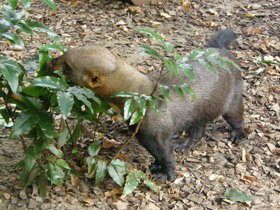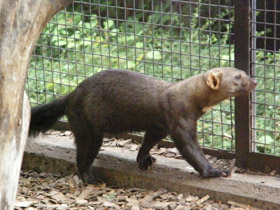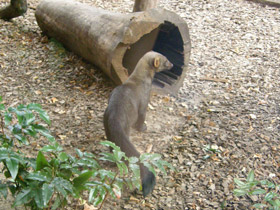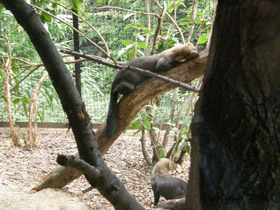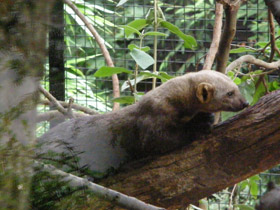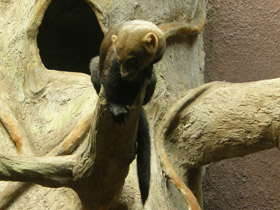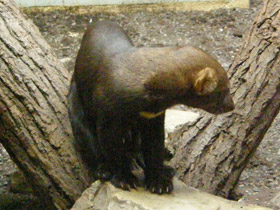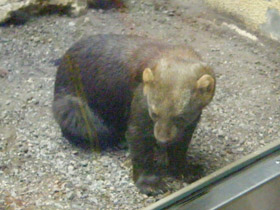The tayra (Eira barbara)
The tayra (Eira barbara) is an omnivorous animal from the weasel family, native to the Americas. It is the only species in the genus Eira.
Tayras are also known as the tolomuco or perico ligero in Central America, motete in Honduras, irara in Brazil, san hol or viejo de monte in the Yucatan Peninsula, and high-woods dog (or historically chien bois) in Trinidad. The genus name Eira is derived from the indigenous name of the animal in Bolivia and Peru, while barbara means "strange" or "foreign".
Appearance
Eira barbara is a species of carnivorous mammal in the family Mustelidae.
The Eira barbara differs greatly in appearance from most species in the family. It is a rather large animal, with a body length of 56-68 cm and a weight of 4-5 kg. The tail of the Eira barbara is long (38-47 cm) and fluffy, its body long and slender, its feet high and its muzzle elongated with small rounded ears and long, stiff vibrissae. Eira barbara's strong paws with strong claws are suitable for running and climbing, but not for digging and swimming. Its coat is thick and short, dyed dark brown, with the head slightly lighter than the rest of the body and a yellow or white patch on the throat.
Habitat and peculiarities
Widespread in Central and South America, it is found from southern Mexico to Bolivia and northern Argentina, as well as on the island of Trinidad. Its favourite habitats are tropical deciduous and evergreen forests. It is not uncommon for the Eira barbara to settle near human settlements, using agricultural plantations to find food. This carnivore has a distinctive voice: when alarmed it barks, but it can also howl, growl and howl in a peculiar way, especially when in a group.
Nutrition and lifestyle
This member of the polecat is omnivorous and hunts a variety of small mammals (agoutis, hares, squirrels, marsupials), birds, reptiles and insects. The Eira barbara is an active hunter, constantly searching for prey and does not attack from ambush. Eira barbara travel up to 7 km a day in search of food. The Eira barbara uses its sense of smell to detect its prey, but its eyesight is poorly developed. In addition to animal food, the Eira barbara also eats fruits of various tropical plants.
This raptor is active at all hours of the day and night, and is an excellent runner, climber and swimmer. The Eira barbara uses its tail as a balancer when moving along branches and tree trunks; it can leap from one tree branch to the trunk or branch of another. The Eira barbara usually makes its home in hollow trees, in burrows dug by other animals and sometimes in tall grass.
Social behaviour and reproduction
Most often occurs in pairs, sometimes in groups of 3-4. Pregnancy of the Eira barbara lasts 63-70 days, and the female gives birth to 2-4 young. Newborns are blind and helpless, covered with wool and weigh between 74 and 92 grams. Their ears do not open until they are one month old, their eyes open even later, between 35 and 58 days of age; their milk dentition begins to erupt at 36 days and the entire dental system is fully developed at 224 days. The mother feeds her young with milk for 2-3 months and the young remain with her for the same length of time. At 3 months of age, they follow the female everywhere and at six months they are indistinguishable from her in size. Eira barbara reach sexual maturity at 18-22 months of age.
In most areas, the Eira barbara is not yet endangered and is the most common animal. The Eira barbara is often domesticated and kept as a pet by the local population.
Subspecies
At least seven subspecies are currently recognised:
- Eira barbara barbara (northern Argentina, Paraguay, western Bolivia and central and southern Brazil);
- Eira barbara inserta (South Guatemala to central Costa Rica);
- Eira barbara madeirensis (west Ecuador and northern Brazil);
- Eira barbara peruana (the eastern Andes in Peru and Bolivia);
- Eira barbara poliocephala (eastern Venezuela, Trinidad, the Guianas, and northeastern Brazil);
- Eira barbara senex (central Mexico to northern Honduras);
- Eira barbara sinuensis (Colombia, western Venezuela, northern Ecuador, and Panama).
Conservation
Wild tayra populations are slowly shrinking, especially in Mexico, due to habitat destruction for agricultural purposes. The species is listed as being of least concern.


















